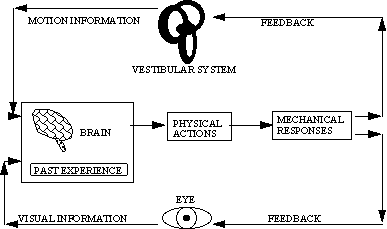
One of the fundamental stimuli in the virtual environments is the information provided by the visual system. To understand its importance, let's consider the way it operates in a "real workload environment" and then the challenge of integrating it into a virtual environment.
All of these requirements can be influenced by mechanical and mental (experienced-based) processes. The drawing below is a basic layout of the human visual system and the three major components that are described in the article.

The eye itself is rather complex in the way it gathers signals from the world. There are basic features similar to the camera, where light is passed through a lens and then converted from energy into small electrical impulses the are supplied to the brain. These impulses are not always interpreted by the brain in the same manner. Some of them will conflict with other information causing a visual system conflict or illusion. The typical conflicts encountered in visual display systems are covered in the latter part of this article.
The vestibular system includes a series of tubes (or canals) that pass through a small chamber. These tubes all have a fluid in them which tends to remain stable for a few seconds when the body moves, then accelerates to the motion of the body, then tends to remain in motion when the body stops moving. Lining the inside of the tubes are tiny hairs, called scilia, which bend when the fluid moves over them. These send sensations (electrical impulses) through the nervous system to the brain. The chamber that interconnects these tubes also has sensitivity, and it too sends information about movement and the force of gravity.
The brain receives these signals from the eye, the vestibular system (and other senses that play less of a role in motion sensing), and compares them with past experiences. These three sets of information should agree with each other. When they do not, which is usually the case, the brain interprets them based on the overall strength of each signal, and the importance of the past events.